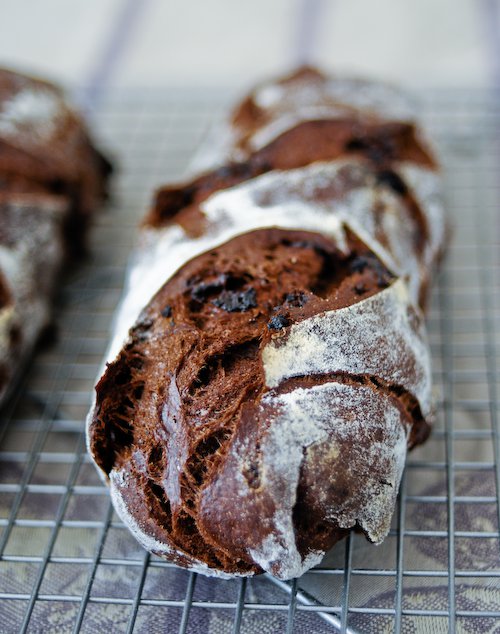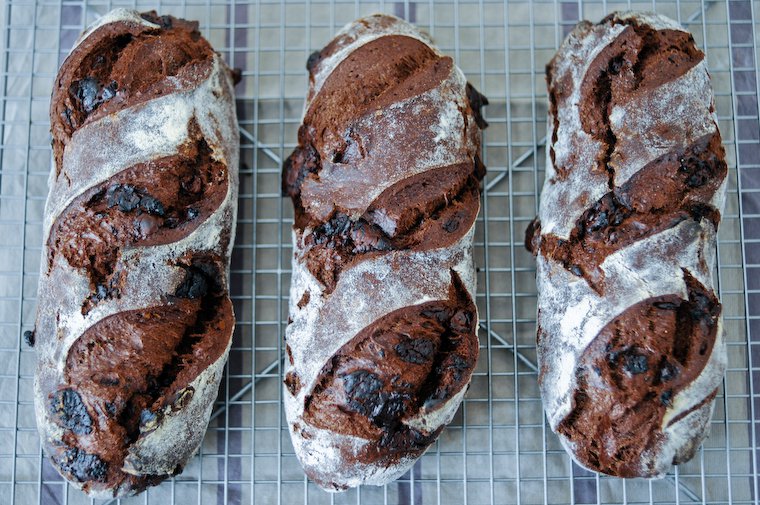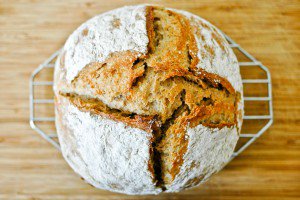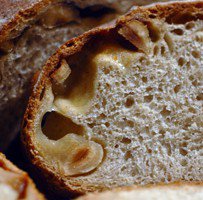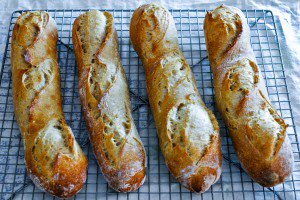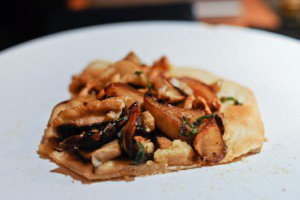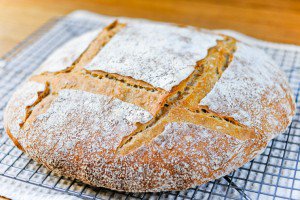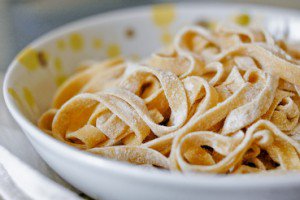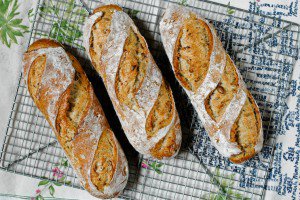Rue des Martyrs, a street that shoots up from the 9th into the 18th arrondissement, is one of those typical Paris market streets that seems to defy business logic by offering no fewer than seven bread bakeries, some of them but a block from one another.
Because I live in the neighborhood, I’ve had the opportunity to sample the goods from (almost*) all of them, and I’ve been particularly impressed with the breads I’ve purchased from Maison Landemaine, on the eastern sidewalk: their tourte de meule (a round rustic loaf) and their baguette**, both leavened with their natural starter, are excellent, and they make a very good chocolate bread, too.
In French, the concept of chocolate bread poses a slight semantics problem, because the name pain au chocolat (literally, chocolate bread) is already taken by a much-loved member of the viennoiserie family that involves croissant dough wrapped around one or two sticks of chocolate to form a rectangular little pad. In some parts of France — especially in the south — this is cutely called a chocolatine.
But what we are talking about here is a regular bread dough that is flavored with cocoa powder and studded with small bits of chocolate — an entirely different animal, one that’s more to my taste. And since I’m always looking for new and delicious ideas to keep my natural starter entertained, it wasn’t long before I decided to make my own.
I remembered Nancy Silverton has a recipe for chocolate cherry bread in her sourdough baking book Breads from the La Brea Bakery, so I looked it up, but hers involves sugar and butter — she developed it to please the customers who came in wanting dessert rather than a loaf of bread — and I wanted my dough unenriched.
Instead, I simply elaborated on the recipe I use for my sourdough baguettes, substituting cocoa powder for part of the flour and folding coarsely chopped chocolate into the dough, and making bâtard-shaped loaves. Because Nancy Silverton notes that the cocoa powder hinders the rise of the bread, I followed her lead and added a little fresh yeast to aid the action of the starter.
Aside from this addition of yeast, the technique is very similar to the one I describe in my baguette post, with an overnight fermentation for flavor and flexibility; you can refer to it for pictures of the different steps.
Because it is just bread with cocoa powder and a little dark chocolate, it is neither too rich nor too sweet for breakfast (i.e. no brick feeling in your stomach, and no sugar crash by mid-morning) and it is a luxurious treat to begin the day with, lightly toasted, and spread with butter or almond butter.
The tight crumb makes it ideal for tartines and I probably don’t need to elaborate on the list of things you can spread on chocolate bread, but I will say this: raspberry jam or dulce de leche make it quite irresistible.
I like it like this, with just chopped chocolate folded in, but you could imagine endless variations, incorporating dried fruit (cherry, fig, prune), orange peel (as in this loaf) or nuts (pistachios, almonds, walnuts), or possibly replacing a little of the wheat flour with chestnut or malt flour.
This bread stays fresh for a few days, like most starter-leavened breads, but if the leftovers dry up they’ll make a fine bread pudding or great breadcrumbs; they’re the ones I used for the Noma-style radishes in soil I wrote about recently.
Maison Landemaine
26 rue des Martyrs, Paris 9ème
M° Notre-Dame de Lorette
+33 (0)1 40 16 03 42 / map it!
* A few of them I didn’t bother to visit; sometimes a glance at the bread shelf is all it takes to form an opinion.
** Bruno Verjus shot a few videos of their baguette-making process.


Have you tried this? Share your pics on Instagram!
Please tag your pictures with #cnzrecipes. I'll share my favorites!
Ingredients
- 200 grams (7 ounces) ripe (100% hydration) starter (see note)
- 540 grams (1 pound 3 ounces) bread flour (I used the French T80, which is partially whole wheat, plus 1 tablespoon wheat gluten)
- 60 grams (1/2 cup) good-quality unsweetened Dutch-process cocoa powder
- 5 grams (1/6 ounce) fresh yeast, crumbled (substitute 1/2 teaspoon active dry yeast; I use the SAF brand)
- 400 grams (14 ounces) filtered water at room temperature
- 2 teaspoons sea salt
- 140 grams (5 ounces) good-quality dark chocolate of your choice (I used one with a 60% cacao content), chopped to chocolate chip size on average (you'll have smaller and larger pieces, that's fine -- use them all)
Instructions
- In a large mixing bowl, or in the bowl of your stand mixer, combine the starter, flour, cocoa powder, yeast, and water until the mixture forms a shaggy mass and all the flour is incorporated.
- Let the mixture sit for 20 to 40 minutes for the autolyse.
- Add the salt, and knead with the dough hook on low speed for 5 minutes, until the dough is smooth and pulls away from the sides of the bowl. Add the chopped chocolate and mix until just incorporated.
- Cover with a kitchen towel and let the dough rest at room temperature for 1 hour. After an hour, fold the dough over itself (as demonstrated in this video) about a dozen times -- this helps give oxygen to the yeasts in the dough, it develops the flavors and builds a well-structured crumb.
- Apply a piece of plastic wrap directly on top of the dough, and a shower cap around the rim of the bowl. Push the shower cap down until it touches the plastic wrap -- you want the cover to be somewhat airtight -- and place the bowl in the fridge for 8 to 12 hours.
- Remove the bowl from the fridge; the dough should have about doubled in size.
- Remove the plastic wrap and replace it with the kitchen towel. Let the dough come back to room temperature, about 1 hour.
- Place a square or rectangular baking stone on the middle rack of your oven and preheat it to 300°C (570°F) or whatever the highest temperature setting is on your oven, for 30 minutes. If you don't have a baking stone, preheat the oven to 240°C (460°C) and line a cookie sheet with parchment paper.
- Have ready a well floured linen kitchen towel that you will reserve for this use (no need to wash it after baking; the more you flour and use it, the less it will stick).
- Turn the dough out onto a well floured surface (I dust an old silicone baking mat heavily with flour). Divide it into three pieces of equal size.
- Shape each piece into a bâtard -- an oval loaf -- as described here.
- After shaping each loaf, place it on the floured kitchen towel and pull the cloth up on each side to form a ridge that will support its shape. Cover with a kitchen towel and allow to rest for the remainder of the preheating.
- During the last 5 minutes of preheating, insert a rimmed baking sheet in the lowest rack of the oven, underneath the pizza stone. Bring about 360 ml (1 1/2 cups) water to the boil in the kettle.
- Just before you're ready to insert the loaves in the oven, make sure you wear something with long sleeves and put on an oven mitt. Using a vessel with a pouring spout (such as a measuring jug), pour half of the boiling water into the rimmed baking sheet -- it will sizzle and steam and it will be a bit scary -- and close the oven door right away.
- This is to create a nice, steamy environment, to foster the formation of a nice crust. Be careful not to burn yourself as you do this -- that is what the long sleeve and oven mitt are for -- and keep kids and pets out of the kitchen for this step.
- If you're using a baking stone, place the loaves on a well-floured pizza peel. Slash each of them 3 times with a baker's blade or a sharp knife, working the blade at a 45° angle. Slide them onto the pizza stone, working quickly to prevent the heat and steam from escaping.
- Pour the remaining water into the rimmed baking sheet, and lower the temperature to 220°C (430°F).
- If you don't have a baking stone, arrange the loaves on the prepared cookie sheet. Slash them as directed and insert into the middle rack of the oven. Pour the remaining water into the rimmed baking sheet, but don't lower the temperature.
- Bake for 40 to 45 minutes, rearranging them after 30 minutes so the ones at the front of the oven will be in the back and vice versa, until the loaves sound hollow when tapped at the bottom. If you're worried they might color too much but they sound like they could use a little more baking, turn off the oven and leave the loaves in for another 15 to 20 minutes.
- Transfer to a rack to cool completely before eating.
Notes
A 100% hydration starter is fed an equal weight of flour and water at every feeding. To learn more about starters, please refer to my post on natural starter bread.
